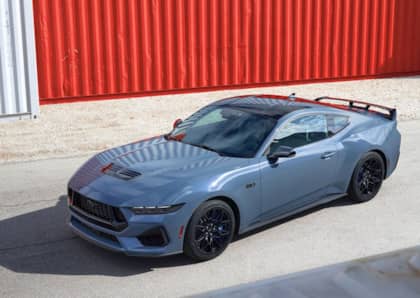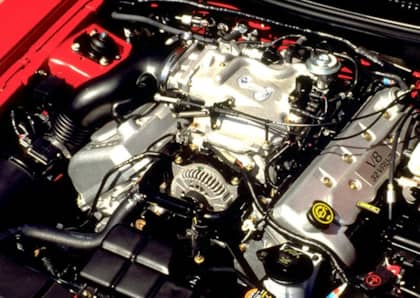What Makes The Ford 8.8 Inch Rear End An Unkillable Choice For Muscle Car Projects?
Ford rear ends have an excellent reputation among drag racers and hot rod builders alike for being able to handle huge amounts of torque without any worries about reliability. While old school builds typically relied on Ford's 9-inch rear (a design that continues to dominate drag racing today), a far more common option for modern performance machines is the Ford 8.8-inch rear end.

Outfitted to millions of Ford Mustangs, Ford F-Series trucks, and Ford Rangers starting back in the early '80s (and later expanding to mid-size and full-size passenger cars), the 8.8 is available in both stick axle and independent rear suspension setups, which also makes it more versatile than the 9-inch. Cheap to source from a local scrap yard, and easily upgraded to meet the specific demands of your drivetrain, the unkillable Ford 8.8 inch rear is the perfect starting point for almost any project.
Big Power Revolution
The 8.8 inch rear end began to get more attention when cheap and plentiful supply of the Ford 9 inch began to dry up. With the number of stock housings dwindling, most aftermarket rear-axle companies moved into manufacturing their own housings, which pushed costs up across the board.

Enter Ford's somewhat lighter, but still strong 8.8 inch unit. Intended to replace the 7.5-inch rear end that had been common on Ford's compact and mid-size models towards the end of the 1970s (and which continued to be used by low-powered FoMoCo options throughout the 1980s), the 8.8 was roughly a third again as strong. This was important for Ford at the time it was introduced in 1983, as the company needed a differential that was inexpensive to build in huge quantities, but which could still handle the climbing horsepower and torque made possible by advancements under the hood as the auto industry climbed out from under the smog-choked Malaise era.

The 8.8 initially appeared in Ford's truck portfolio in 1983, and by 1986 it had replaced the 7.5-inch rear end in V8 versions of the Mustang as well. It wasn't long before the 8.8 had migrated to the of the Ford rear-wheel drive portfolio, showing up in vehicles as diverse as the Thunderbird, the Explorer, and the Crown Victoria. Lincoln also got in on the 8.8-inch act, adding the first independent rear suspension (IRS) version to the Lincoln Mark VIII in 1993, and later installed in the Mustang Cobra from 1999 to 2004 (with an independent front suspension 8.8 also offered on the Ford F-150 and the Ford Expedition SUV starting a few years later).

The design started to phase out from F-Series production in the mid-2000s, eventually replaced by the Super 8.8 and the 9.75 inch designs.
Spline Split
The automaker maintained its standard 28-spline and 31-spline split for the 8.8's axles. Almost every 1986-and-up 5.0L and 4.6L Mustang built on the Fox, SN95, and New Edge platforms made use of the 28 spline design (which is good up to about 400 horsepower), with the exception of the 2001 Cobra as well as the 2003-2004 Terminator Cobras, which featured the 31-spline design.

The latter is about 30 percent stronger (nearly matching the very similar GM 12-bolt rear end for toughness), and it was made standard for the 5.0L S197 Mustang from 2005 to 2014 (with V6 models getting in on the action starting in 2011). The 31 spline was also commonly found in F-150 pickups and E-Series vans, as well as certain Ranger model years.

Gear sets are interchangeable between 28 spline and 31 spline versions of the rear end. Some 8.8 rear ends offered the Ford Traction-Lok limited-slip and can usually be identified by the presence of an 'L' in the ID tag inside the gear ratio listing. A very wide range of ratios were built, with tall 4.10:1 gears the most aggressive offered by the factory on the truck side. Post-1988 differentials may also offer anti-lock brake sensor mounts.
A Solution For (Nearly) Everyone
The 8.8 inch setup is amazingly versatile, fitting under a wide range of platforms including modern muscle machines like the first-generation CTS-V all the way back to 1960s-era Jeeps and even the original Mustang itself (with Fox Mustang rear ends barely a hair wider than the classic models).

The overall width of the 8.8 setup measures between 56/5 inches and 65 inches, and the differential housing is adaptable to almost any rear suspension design, with aftermarket mounts available in kit form. Keep in mind that Fox body Mustang axles are four-lug, which means if you're looking for a more modern five-lug pattern you'll want to seek out later axles such as those from the Explorer SUV or the Ranger pickup.

Like the 9-inch, the 8.8 inch enjoys fantastic support from aftermarket vendors. There are really no limits on what gearing can be installed in the pumpkin, or what adaptor might be needed to make the rear end find a specific application. Combine that with the affordable cost of the 8.8 and it's clear why it's become the backbone of modern high horsepower project car and truck builds.











